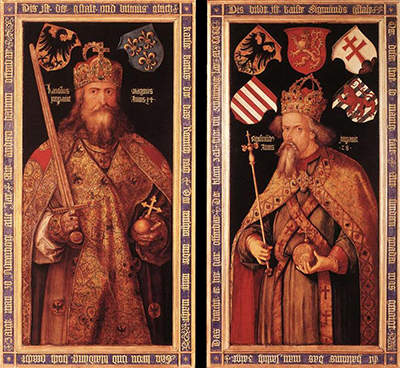The Nuremberg city council ordered a pair of portraits of Emperor Charlemagne and Emperor Sigismund and they were Dürer's only commission for panel paintings from Nuremberg's city council. They were intended for the Treasure Chamber, where the imperial regalia was kept the night before they went on their annual ceremonial display to the people.
It is believed that his paintings were ordered to replace previous works, which had been painted after the imperial regalia were deposited in Nuremberg in 1424 by Sigismund of Luxemburg. Charlemagne ruled from 800-814 and his portrait was invented by Dürer, who depicted him in an imposing posture because no resemblance is known of Charlemagne. Sigismund ruled from 1410-1437 and Dürer’s depiction of him must have been inspired by a portrait of him done during his reign. Both panels contain the appropriate coat of arms, the German eagle and French fleur-de-lis for Charlemagne. Sigismund’s panel also includes the arms of the regions governed by Sigismund, Bohemia, the German Empire, Old and New Hungary and Luxemburg. The lettering state their names and the number of years they reigned, 14 years and 28 years for Charlemagne and Sigismund, respectively.
There are explanatory texts depicted around the four sides of the paintings. The first painting states the number of years Charlemagne was in power, his father, how he made the Roman Empire subject to German rule and that his regalia and other relics are annually displayed at Nuremberg. The second painting states the duration of Sigismund in power, his friendliness, the display of favour to Nuremberg and how he brought the relics annually displayed there in 1424. Dürer researched every piece of regalia and accurately depicted them in the paintings. Charlemagne has the imperial crown on and adorns it with his sword and orb. Sigismund wears a Gothic crown and embellishes it with a sceptre and orb. Dürer early influences were his father, a goldsmith and his godfather, a painter. He also likely drew his inspiration from Giovanni Bellini and he once wrote that he was the best artist. Dürer also inspired various artists with his work of art, including Marcantonio Raimondi, Cristofano Robetta, Rembrandt and many more.
- Painted by Albrecht Dürer
- Date: circa 1512
- Genre: Portrait
- Style: Northern Renaissance
- Medium: Oil and tempera on panel
- Location: Germanisches Nationalmuseum, Nuremberg, Germany
- Dimensions: Width: 115 cm (45.2 in); Height: 215 cm (84.6 in) (each including frame)




